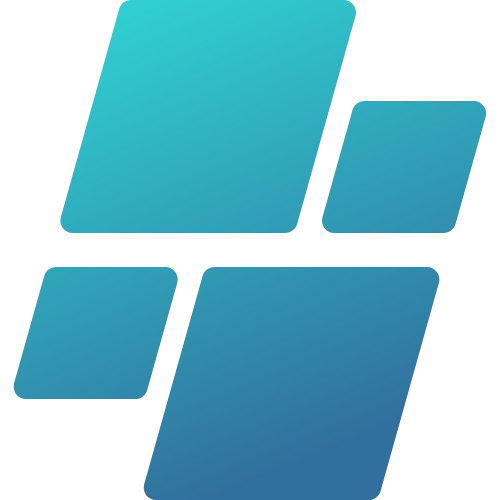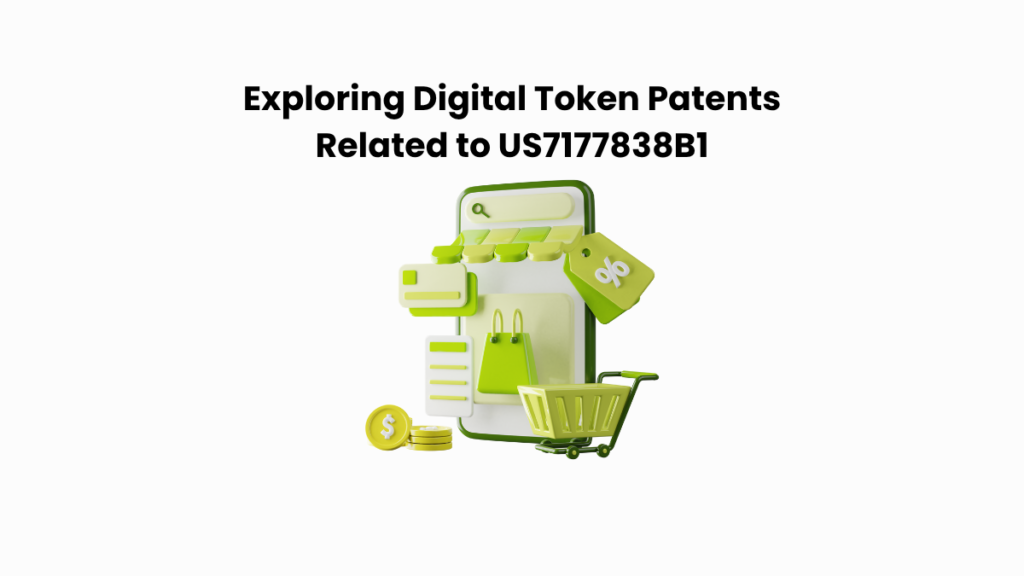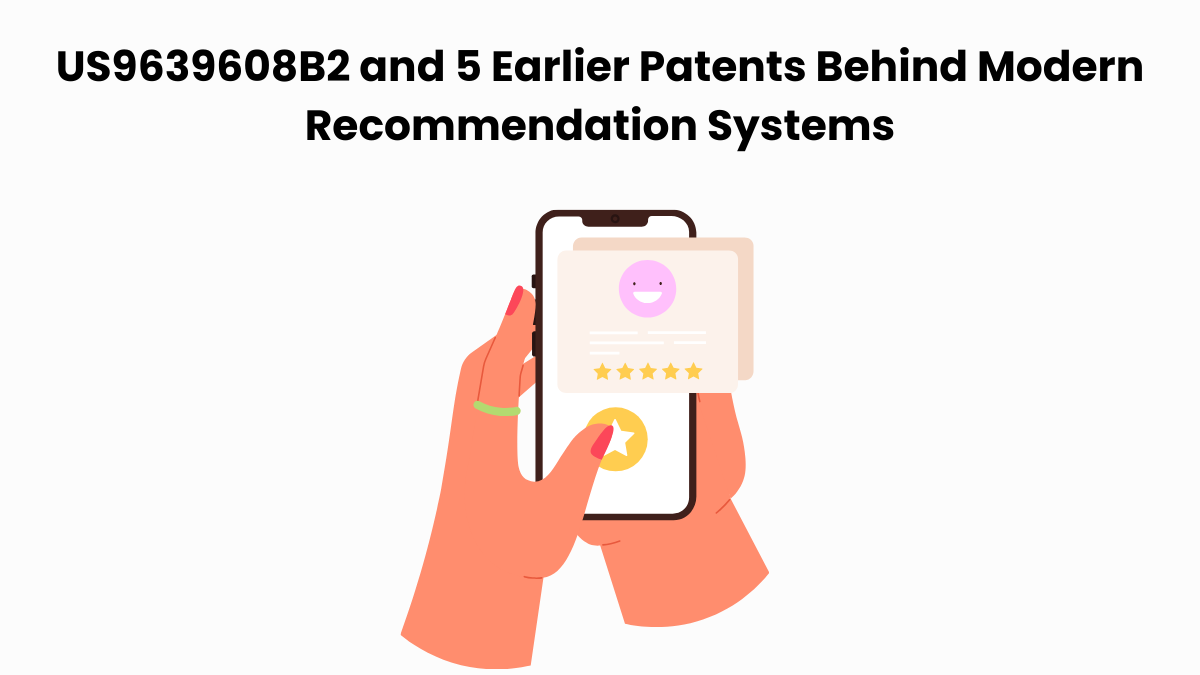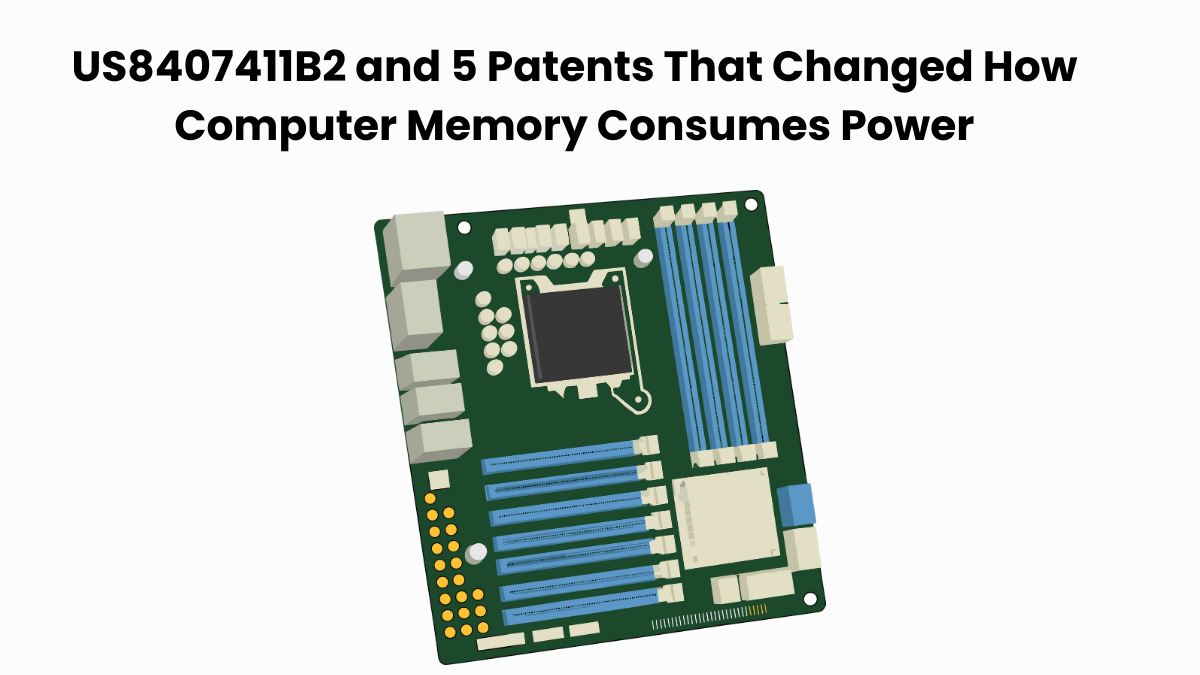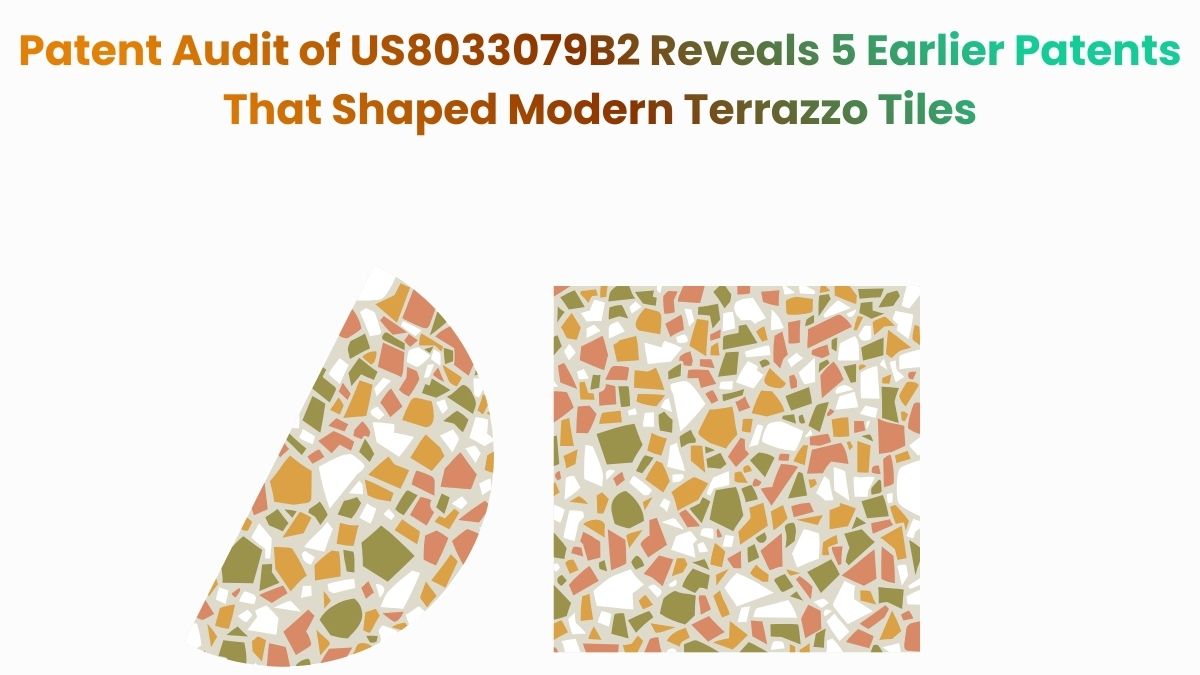Some patents introduce quiet shifts in how digital systems work. Others, such as US7177838B1, stand out for rethinking foundational mechanisms in electronic commerce.
Now cited in the case of AML IP, LLC v. Orveon Global US LLC, this patent outlines a method for using vendor-issued electronic tokens. These tokens let users purchase or rent products directly without relying on third-party payment systems. Vendors can control pricing, issue tokens online or offline, and offer flexible rental options for digital goods.
In this article, we use the Global Patent Search (GPS) platform to explore similar technologies. We’re not focusing on the legal case itself. Instead, we’re mapping patents that share key concepts, like direct digital transactions and token-based commerce. If you’re interested in fintech systems, IP analysis, or e-commerce frameworks, this data-driven overview is worth a closer look.
Recommended read: From Concept to Comparison: A Stress Test of US9450956B1’s Proximity Authentication System, a deep dive into proximity-based login and digital identity systems.
Understanding Patent US7177838B1
US7177838B1 describes a method and system for conducting electronic commerce using vendor-issued electronic tokens. These tokens are directly managed by the vendor and can be used by users to purchase or rent products and services. Unlike conventional systems, this approach eliminates the need for third-party financial institutions, thereby reducing overhead and enhancing privacy. The system supports both online and offline token purchases, enabling flexible and scalable digital transactions.
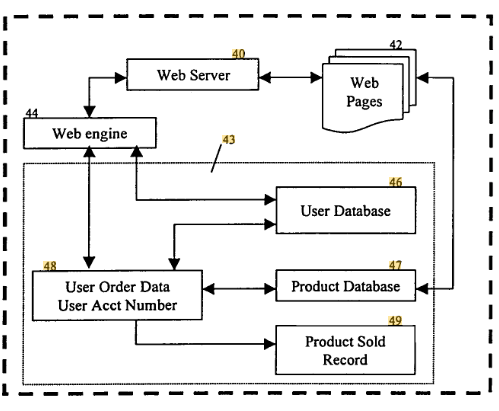
Source: Google Patents
Its four key features are
#1. Vendor-controlled electronic tokens: Vendors issue and redeem tokens themselves without involving external banks or intermediaries.
#2. Multi-channel payment support: Tokens can be bought online via credit card or offline through checks, money orders, or purchase orders.
#3. Dynamic rental and purchase models: The software can be rented for specific durations, usage counts, or processing limits. Tokens can also be used to extend or convert rentals.
#4. Efficient micropayment system: Enables low-cost transactions for digital goods that may not justify typical credit card processing fees.
This patent offers a scalable architecture for token-based commerce. Its flexible handling of digital rentals, micropayments, and token management makes it relevant in contexts where transaction costs and user privacy are key concerns. The system also supports modular licensing, a model increasingly used in cloud services and digital content platforms.
Recommended Read: Want to see how digital finance models are evolving beyond credit cards and banks? Explore embedded finance startups reshaping how transactions work.
Similar Patents As US7177838B1
To explore the innovation landscape surrounding US7177838B1, we ran the patent through the Global Patent Search tool. Below is a quick glimpse of the GPS tool in action:
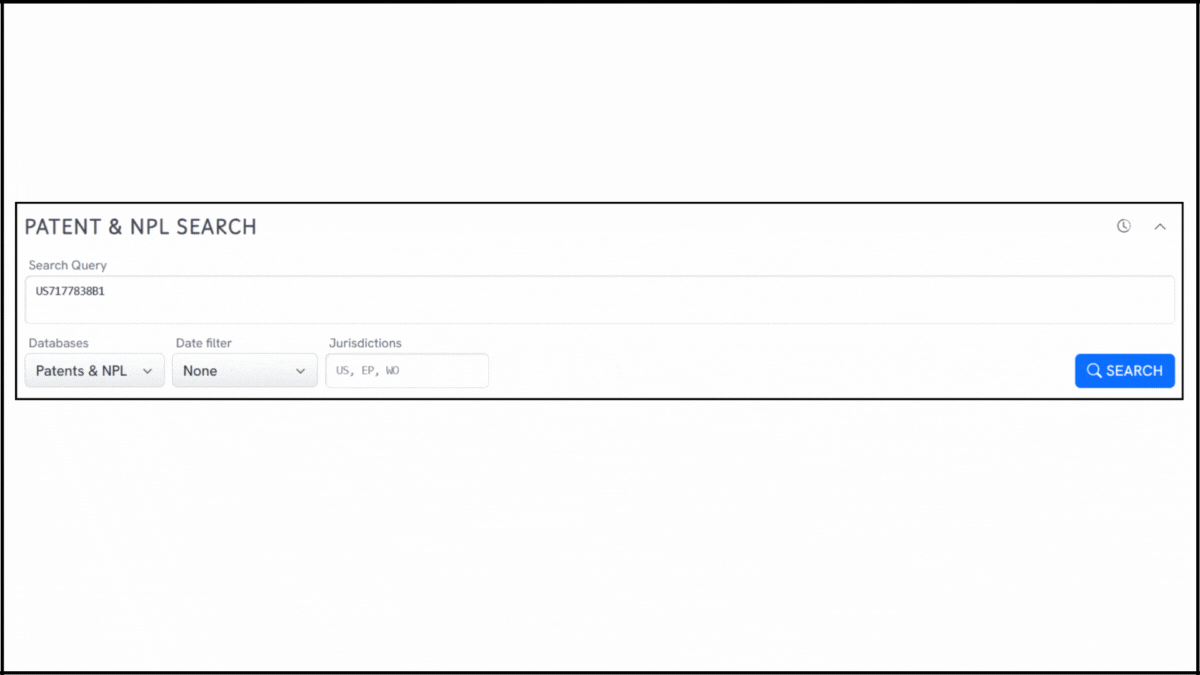
Source: Global Patent Search
This search revealed several patents that share structural and transactional similarities with the vendor-issued token framework described in US7177838B1. Below, we highlight five related patents that reflect comparable ideas in digital commerce, token control, and micropayment systems. These examples provide insight into how similar transactional challenges have been addressed across distributed platforms.
#1. US5930777A
This US patent, US5930777A, published in 1999, outlines a method for charging users on a pay-per-access basis using secure, third-party-minted tokens. It supports both vendor-side and banker-side token validation, operating without requiring additional hardware or software for either party.
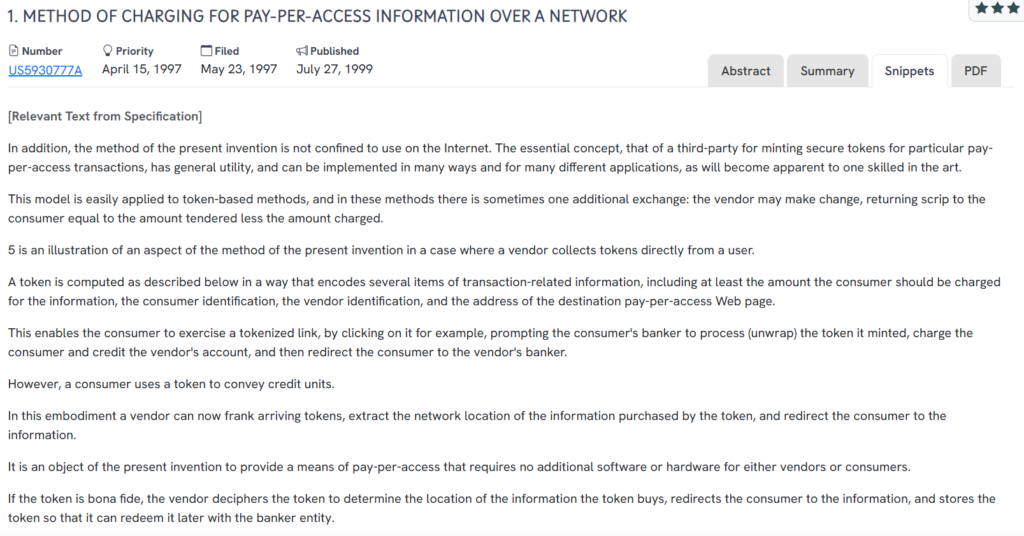
Source: GPS
What this patent introduces to the landscape?
- Third-party token issuance – Tokens are minted by a banking entity and encode transaction-specific data such as vendor ID, access amount, and destination URL.
- Pay-per-access content delivery – Allows users to purchase individual access to digital content using tokenized links.
- Vendor-side verification and redirection – Vendors can validate incoming tokens, confirm authenticity, and redirect users to the purchased content.
- Support for transaction “change” – Vendors can return partial balances as scrip if the token amount exceeds the purchase price.
- Built-in anonymity – Some embodiments allow consumers to transact anonymously using token-based methods.
To compare token-based encryption with recursive multi-layered systems, check out the related patent analysis of US7203844B1.
How it connects to US7177838B1?
While US5930777A relies on third-party-minted tokens, and US7177838B1 centers on vendor-issued tokens, both patents contribute to the development of flexible, token-based transaction systems that bypass traditional credit infrastructure.
- Both systems utilize tokens as a digital payment mechanism for accessing products or services.
- Each design supports micropayment models, enabling transactions that would otherwise be too small for credit card processing.
- They promote security and control, either through third-party authentication (US5930777A) or direct vendor management (US7177838B1).
Why this matters?
US5930777A illustrates a parallel track in the evolution of tokenized digital commerce, focusing on access-based transactions and third-party processing. It complements the closed-loop architecture of US 7177838 B1 by offering insights into secure token exchange within broader payment ecosystems.
#2. CA2314098A1
This Canadian patent, CA2314098A1, published in 1999, describes a flexible payment system using electronic tokens to facilitate transactions over a network. The invention is designed to support deferred authorization, third-party token distribution, and irregular-use service models.
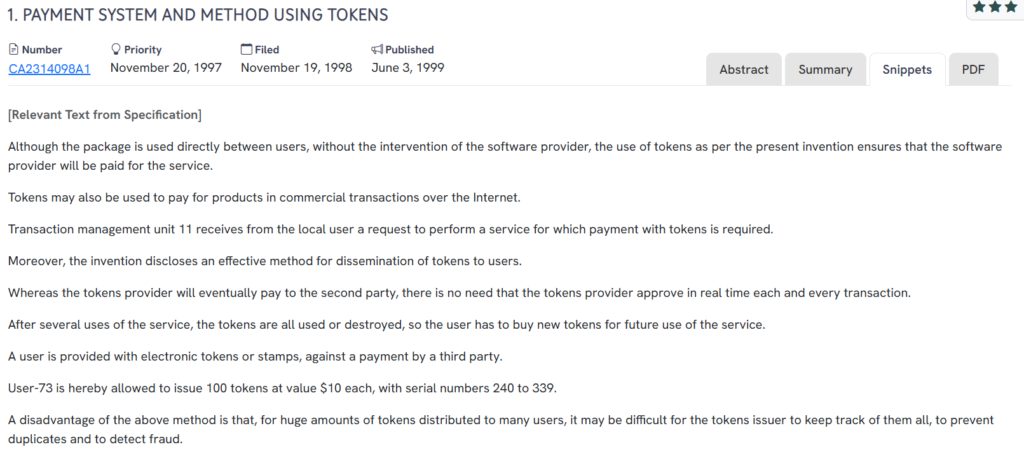
Source: GPS
What this patent introduces to the landscape?
- Deferred transaction authorization – Transactions do not require real-time approval from the token issuer, allowing smoother operation for high-volume systems.
- Token-based payment for irregular services – Supports services where users prefer to pay per use rather than subscribe or pay upfront.
- Third-party token funding – Tokens may be provided to users by a third party, enabling prepaid access or sponsored transactions.
- Serialized and traceable tokens – Tokens are issued with unique serial numbers, supporting security, traceability, and fraud prevention.
- Decentralized use with centralized settlement – While users exchange tokens directly, the software provider or token issuer ultimately receives payment, maintaining trust in the system.
How it connects to US7177838B1?
CA2314098A1 shares several conceptual parallels with US7177838B1 in the realm of digital token systems. Both focus on enabling electronic commerce through non-bank-mediated payment mechanisms.
- Both inventions support token-based digital transactions that eliminate reliance on credit card gateways.
- Each system emphasizes vendor or issuer control over the issuance and tracking of tokens.
- They accommodate non-subscription, usage-based payments, which are well-suited for services accessed on demand.
Why this matters?
CA2314098A1 proposes a decentralized approach to token exchange, while ensuring eventual payment to service providers. It complements the centralized vendor model of US7177838B1 by addressing scalability, third-party involvement, and per-use billing, all critical to supporting broader token adoption in digital commerce ecosystems.
Did you know? Just like messaging patents raised legal scrutiny, financial imaging patents are under fire. US10140514B1 illustrates how ephemeral-style image handling adapts to bank check verification.
#3. US6453305B1
This US patent, US6453305B1, published in 2002, introduces a method and system for enforcing software licenses on an open network using temporary, token-like scrip. These digital scrip units operate as license carriers and can be automatically processed by consumer-side systems.
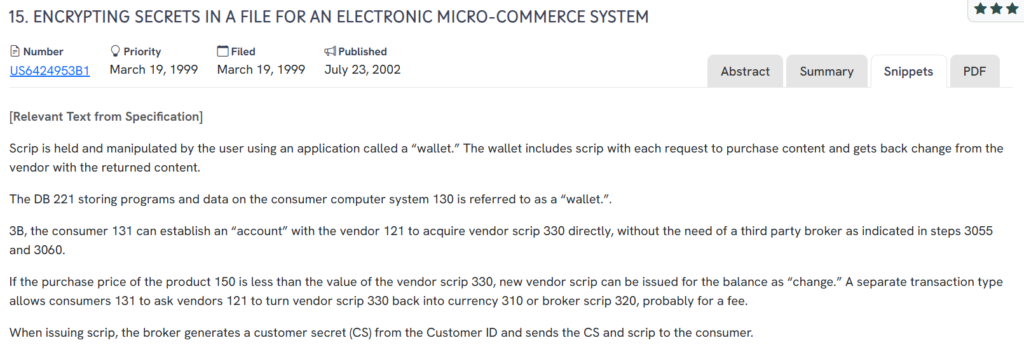
Source: GPS
What this patent introduces to the landscape?
- License scrip for temporary access – Introduces digital scrip as a substitute for conventional software keys, enabling time-limited or usage-based licensing.
- Broker-managed scrip issuance – A centralized broker system handles scrip generation and distributes it to consumers on demand.
- Consumer-side wallet management – Consumers use a digital “wallet” that automates the handling, storage, and redemption of scrip.
- Flexible identity verification – Vendors may authenticate consumers using cookies, shared tables, or manual input during scrip redemption.
- Non-monetary scrip capability – Scrip can be issued free of charge, allowing vendors to control access without requiring direct payment.
How it connects to US7177838B1?
US6453305B1 and US7177838B1 both utilize token-like mechanisms to manage digital transactions and access, although their focus differs, licensing versus purchasing.
- Both patents rely on non-bank digital currency or token systems to manage access or value exchange.
- Each supports temporary or conditional access, whether it’s for content, software, or services.
- They incorporate automated client-side components, like a wallet or token database, to handle user interactions with minimal friction.
Why this matters?
US6453305B1 presents an alternate route to access control through a temporary licensing scrip. Its focus on license enforcement, automation, and user-side processing aligns with the broader goals of US7177838B1 in creating low-overhead, secure, and scalable digital commerce solutions.
#4. US6424953B1
This US patent, US6424953B1, published in 2002, describes a micro-commerce system where encrypted vendor scrip is used as a form of digital currency. The system supports wallet-based transactions, scrip redemption, and even conversion back to traditional currency.
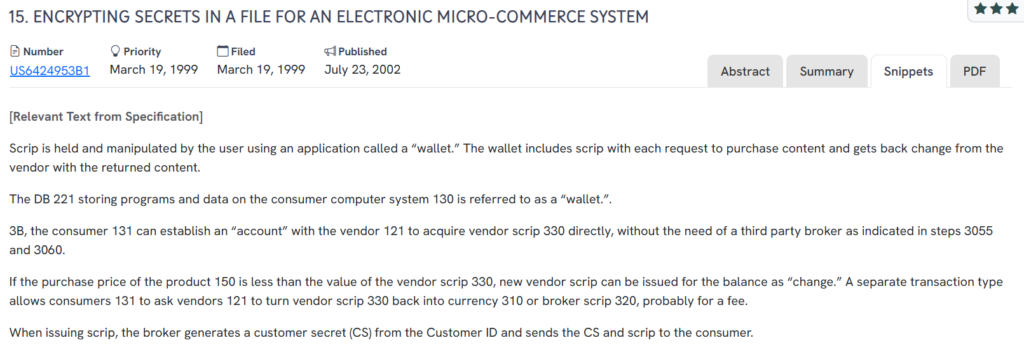
Source: GPS
What this patent introduces to the landscape?
- Encrypted vendor scrip – Digital currency issued by vendors can be securely stored and processed by users for purchasing digital goods.
- Client-side wallet management – A digital wallet stores scrip, submits it with content requests, and handles returned “change.”
- Direct vendor-issued scrip – Users can acquire scrip directly from vendors, bypassing third-party brokers.
- Scrip redemption and currency conversion – Users can request that vendors convert leftover scrip into currency or broker-issued equivalents, often with a fee.
- Customer secret encryption – The system encrypts user identity data when issuing scrip to enhance privacy and prevent misuse.
How it connects to US7177838B1?
US6424953B1 and US7177838B1 both provide vendor-managed digital payment systems for purchasing online content or services. Their use of digital scrip and token control reveals strong architectural alignment.
- Both systems allow direct vendor issuance of value units (tokens or scrip) to users without banks or brokers.
- Each supports wallet-style account tracking, where balances are managed and deducted during transactions.
- They both facilitate change handling and flexible payment flows, enabling fine-grained control of small or partial payments.
Why this matters?
US6424953B1 demonstrates how vendor-issued digital scrip can function securely and autonomously in micro-commerce environments. Its encryption and wallet mechanisms mirror the operational goals of US7177838B1, efficient, user-friendly, and controlled digital transactions.
#5. KR20000067276A
This Korean patent, KR20000067276A, published in 2000, describes an e-commerce system centered on cyber tickets, which serve as prepaid gift certificates. The system focuses on secure issuance, transfer, and redemption of these tickets as an alternative to credit-based or account-linked payment methods.

Source: GPS
What this patent introduces to the landscape?
- Cyber ticket as digital gift certificate – Introduces a prepaid, voucher-style system where users purchase tickets in advance and redeem them during product transactions.
- Full-cycle ticket management – Covers the issuance, distribution, transfer, and disposal of cyber tickets, ensuring integrity at every stage.
- Alternative to credit and debit systems – Replaces the complexity and risk of deferred payments with a user-controlled, prepaid method.
- Simplified payment processing – Eliminates the need for real-time credit card verification during multi-product purchases.
- Security and usability focus – Designed to streamline online commerce while minimizing consumer financial burden and vendor-side processing load.
How it connects to US7177838B1?
KR20000067276A and US7177838B1 both offer prepaid, vendor-oriented transaction frameworks that reduce dependency on traditional financial networks. Each promotes secure and flexible methods for digital payment.
- Both use preloaded, vendor-approved value units (tokens or cyber tickets) as the medium of exchange.
- Each system allows users to control spending upfront, reducing the need for post-transaction reconciliation.
- They aim to reduce transaction complexity, particularly when handling multiple product purchases online.
Why this matters?
KR20000067276A strengthens the concept of prepaid, self-contained payment ecosystems in e-commerce. Its approach to secure, ticket-based transactions parallels the token mechanisms of US7177838B1, offering another route to minimizing reliance on external banking and credit infrastructure.
The evolution of tokenized biometric security is further explored in US11095640B1.
How to Find Related Patents Using Global Patent Search?
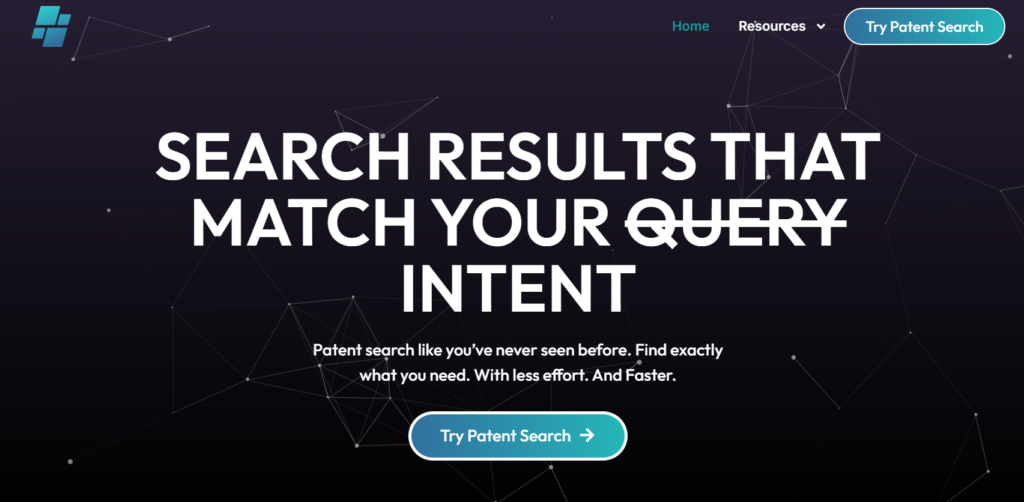
Understanding the broader innovation landscape around a patent can be essential for refining digital payment systems, designing token-based transaction models, or exploring scalable micro-commerce solutions. The Global Patent Search tool streamlines this task by helping users identify inventions that share similar transactional structures or payment workflows. Here’s how it works:
1. Enter the patent number into GPS: Start by entering a patent number, such as US7177838B1, into the GPS platform. The tool converts it into a smart semantic query, which can be refined using terms like “token,” “scrip,” or “micropayment.”

2. Explore conceptual snippets: Rather than mapping features line by line, GPS now reveals intelligent text snippets. These highlight functionally similar language in other patents, making it easier to identify parallel ideas in payment flow, access control, or wallet systems.

3. Identify related inventions: The tool returns a curated list of patents that share architectural logic, such as prepaid models, digital tokens, or deferred transaction handling, offering insights into how similar problems have been approached.
4. Compare system logic, not legal claims: GPS emphasizes core functionality and design principles. It enables users to compare how systems behave rather than interpret claim language, making it ideal for technical analysis over legal parsing.
5. Accelerate strategic discovery: Whether you’re working on fintech platforms, e-commerce backends, or tokenized access models, GPS helps you explore the broader patent ecosystem, revealing adjacent innovations you might otherwise miss.
By focusing on architecture, interaction flow, and system design, Global Patent Search provides engineers and analysts with a concept-driven view of related technologies. This can empower smarter product development and a more informed IP strategy.
Disclaimer: The information provided in this article is for informational purposes only and should not be considered legal advice. The related patent references mentioned are preliminary results from the Global Patent Search tool and do not guarantee legal significance. For a comprehensive related patent analysis, we recommend conducting a detailed search using GPS or consulting a patent attorney.
